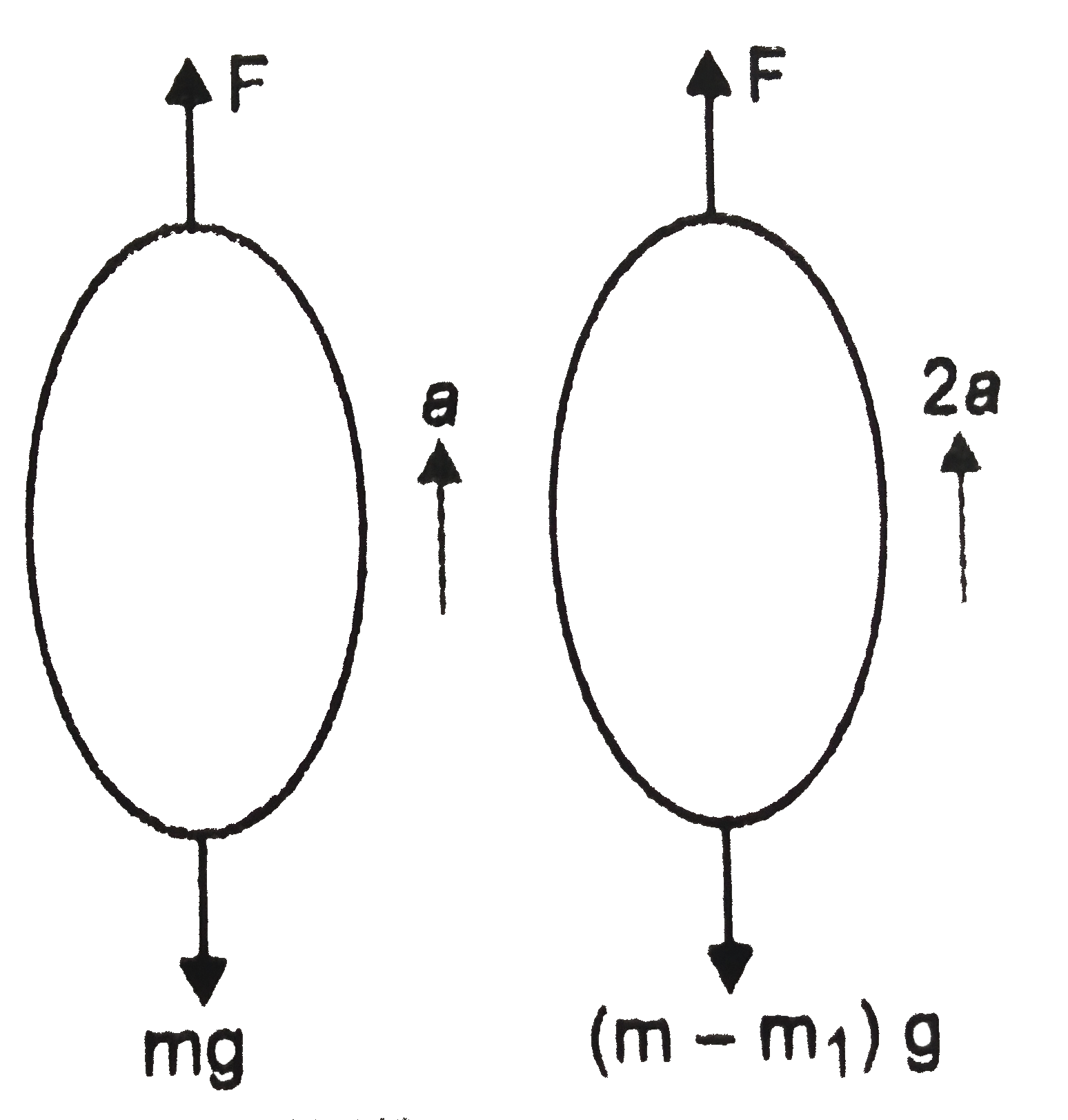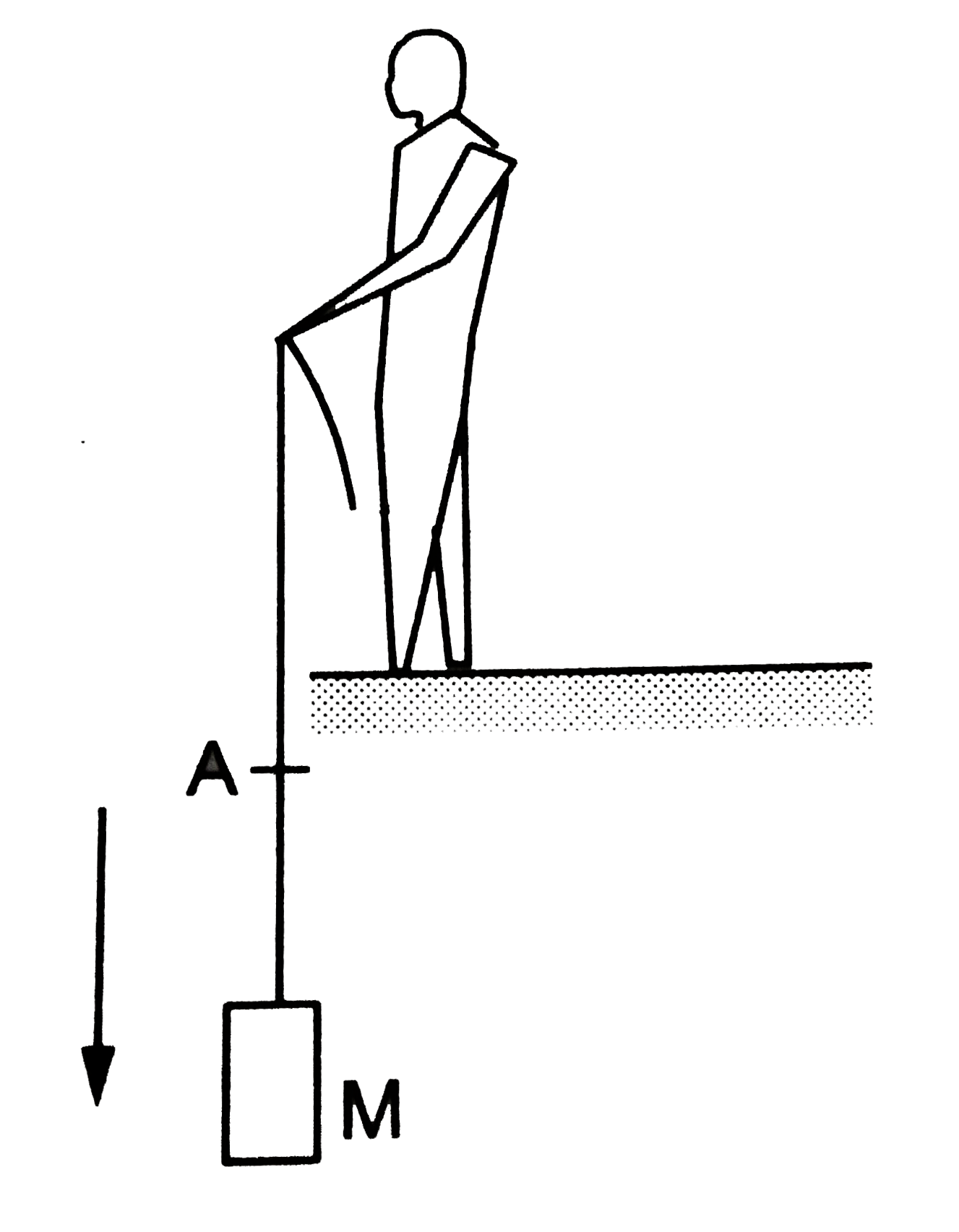A balloon of mass M descends with an acceleration . The mass that must be thrown out in order to give the balloon an equal upwards acceleration will be
The correct Answer is:C
To solve the problem of determining the mass that must be thrown out of a descending balloon to give it an equal upward acceleration, we can follow these steps:
1. Identify the Forces Acting on the Balloon:
- The weight of the balloon is given by W=Mg, where M is the mass of the balloon and g is the acceleration due to gravity.
- The balloon is descending with an acceleration a0.
2. Apply Newton's Second Law:
- When the balloon descends with an acceleration a0, the net force acting on it can be expressed as:
Fnet=Mg−Fbuoyancy=Ma0
- Rearranging gives us:
Fbuoyancy=Mg−Ma0
3. Consider the Situation After Throwing Mass:
- Let m be the mass that is thrown out of the balloon.
- The new mass of the balloon becomes M−m.
- We want the balloon to ascend with an acceleration equal to a0. The net force acting on the balloon now is:
Fnet=Fbuoyancy−(M−m)g=(M−m)a0
4. Set Up the Equation:
- From the buoyancy force, we have:
Fbuoyancy=(M−m)g+(M−m)a0
- Setting the two expressions for buoyancy equal, we get:
Mg−Ma0=(M−m)g+(M−m)a0
5. Simplify and Solve for m:
- Expanding the right side:
Mg−Ma0=Mg−mg+Ma0−ma0
- Rearranging gives us:
Ma0+mg−ma0=0
- Rearranging terms leads to:
m(a0+g)=2Ma0
- Finally, solving for m:
m=2Ma0g+a0
Final Result:
The mass that must be thrown out to give the balloon an equal upward acceleration is:
m=2Ma0g+a0
- The weight of the balloon is given by W=Mg, where M is the mass of the balloon and g is the acceleration due to gravity.
- The balloon is descending with an acceleration a0.
- When the balloon descends with an acceleration a0, the net force acting on it can be expressed as:
Fnet=Mg−Fbuoyancy=Ma0
- Rearranging gives us:
Fbuoyancy=Mg−Ma0
- Let m be the mass that is thrown out of the balloon.
- The new mass of the balloon becomes M−m.
- We want the balloon to ascend with an acceleration equal to a0. The net force acting on the balloon now is:
Fnet=Fbuoyancy−(M−m)g=(M−m)a0
- From the buoyancy force, we have:
Fbuoyancy=(M−m)g+(M−m)a0
- Setting the two expressions for buoyancy equal, we get:
Mg−Ma0=(M−m)g+(M−m)a0
- Expanding the right side:
Mg−Ma0=Mg−mg+Ma0−ma0
- Rearranging gives us:
Ma0+mg−ma0=0
- Rearranging terms leads to:
m(a0+g)=2Ma0
- Finally, solving for m:
m=2Ma0g+a0
The mass that must be thrown out to give the balloon an equal upward acceleration is:
m=2Ma0g+a0
Topper's Solved these Questions
- BOOK - DC PANDEY ENGLISHCHAPTER - FLUID MECHANICSEXERCISE - Level 1 Subjective36videos
FLUID MECHANICS
- BOOK - DC PANDEY ENGLISHCHAPTER - FLUID MECHANICSEXERCISE - Subjective Question2videos
FLUID MECHANICS
- BOOK - DC PANDEY ENGLISHCHAPTER - FLUID MECHANICSEXERCISE - Assertion and Reason1videos
FLUID MECHANICS
- BOOK - DC PANDEY ENGLISHCHAPTER - EXPERIMENTSEXERCISE - Subjective15videos
EXPERIMENTS
- BOOK - DC PANDEY ENGLISHCHAPTER - GENERAL PHYSICSEXERCISE - INTEGER_TYPE2videos
GENERAL PHYSICS
Similar Questions
A balloon of mass m is descending down with an acceleration How much mass should be g2 removed from it so that it starts moving up with same acceleration?
View SolutionA balloons of mass M is descending at a constant acceleration α. When a mass m is released from the balloon, it starts rising. With the same acceleration α. Assuming that its volumes does not change, what is the valule of m?
View SolutionA balloons of mass M is descending at a constant acceleration α. When a mass m is released from the balloon, it starts rising. With the same acceleration α. Assuming that its volumes does not change, what is the valule of m?
View SolutionA ballon of mass m is rising up with an acceleration a show that the fraction og weight of balloon that must be detached in order to double its acceleration , assuming the upthrust of air to remain the same
 View Solution
View SolutionThe block shown in figure has a mass M and descends with an acceleration a. The mass of the string below the point A is m. Find the tension of the string at the point A and at the lower end.
 View Solution
View SolutionA balloon of mass 10 kg is raising up with an acceleration of 20ms−2. If a mass of 4 kg is removed from the balloon its acceleration becomes ( take, g=10ms−2)
View SolutionA balloon with its contents weighing 160 N is moving down with an acceleration of g/2 ms−2 . The mass to be removed from it so that the balloon moves up with an acceleration of-g/3 ms−2 is
View SolutionA balloon is descending with a constant acceleration a, less than the acceleration due to gravity g. The weight of the balloon, with its basket and contents, is w. What weight w, should be released so that the balloon will begin to accelerate upward with constant acceleration a? Neglect air resistance.
View SolutionA balloon with mass m is descending down with an acceleration a (wherea<g) . How much mass should be removed from it so that it starts moving up with an acceleration a?
View SolutionA balloon os mass 2 KG is rising up with an acceleration of 4ms2 . The upward force acting on the balloon is (g = 10 ms^-2)
View Solution

